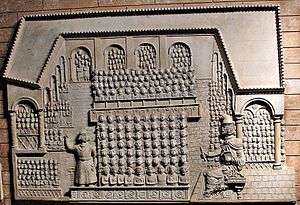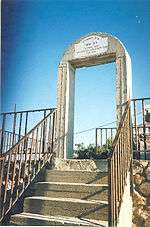Rav Ashi
- For the seventh generation Amora sage of Babylon, see Mar b. Rav Ashi (his son).
| Rabbinical Eras |
|---|

Rav Ashi (Hebrew: רב אשי) ("Rabbi Ashi") (352–427) was a Babylonian Amoraic Talmid Chacham, who reestablished the Academy at Sura and was first editor of the Babylonian Talmud. According to a tradition preserved in the academies, Rav Ashi was born in the same year that Rava, the great teacher of Mahuza, died, and he was the first teacher of any importance in the Talmudic Academies in Babylonia after Raba's death. Simai, Ashi's father, was a rich and learned man, a student of the college of Naresh near Sura, which was directed by Rav Papa, Raba's disciple. Ashi's teacher was Rav Kahana, a member of the same college, who later became president of the academy at Pumbedita.
Compilation of the Gemara
While still young, Rav Ashi became the head of the Sura Academy, his great learning being acknowledged by the older teachers. It had been closed since Rav Chisda's death (309), but under Rav Ashi it regained all its old importance. His commanding personality, his scholarly standing, and wealth are sufficiently indicated by the saying, then current, that since the days of Rabbi Judah haNasi, "learning and social distinction were never so united in one person as in Ashi." Indeed, Rav Ashi was the man destined to undertake a task similar to that which fell to the lot of Judah I. The latter compiled and edited the Mishnah; Rav Ashi made it the labor of his life to collect after critical scrutiny, under the name of Gemara, those explanations of the Mishnah that had been handed down in the Babylonian academies since the days of Rab, together with all the discussions connected with them, and all the halakhic and haggadic material treated in the schools.
Conjointly with his disciples and the scholars who gathered in Sura for the "Kallah", or semi-annual college conference, he completed this task. The kindly attitude of King Yazdegerd I, as well as the devoted and respectful recognition of his authority by the academies of Nehardea and Pumbedita, greatly favored the undertaking. A particularly important element in Ashi's success was the length of his tenure of office as head of Sura Academy, which must have lasted 52 years, but with tradition, probably for the sake of round numbers, was exaggerated into 60. According to the same tradition, these 60 years are said to have been so symmetrically apportioned that each treatise required six months for the study of its Mishnah and the redaction of the traditional expositions of the same (Gemara), thus aggregating 30 years for the 60 treatises. The same process was then repeated for thirty years more, at the end of which period the work was considered complete.
Rav Ashi actually revised the work twice—a fact that is mentioned in the Talmud. Beyond this, the Talmud itself contains not the slightest intimation of the activity which Ashi and his school exercised in this field for more than half a century. Even whether this editorial work was written down, and thus, whether the putting of the Babylonian Talmud into writing took place under Rav Ashi or not, cannot be answered from any statement in the Talmud. It is nevertheless probable that the fixation of the text of so comprehensive a literary work could not have been accomplished without the aid of writing.
The work begun by Rav Ashi was continued in the two succeeding generations and completed by Ravina II, another president of the college at Sura, who died in 499. To the work as the last-named left it, only slight additions were made by the Saboraim. To one of these additions—that to an ancient utterance concerning the "Book of Adam, the First Man,"—this statement is appended: "Ashi and Ravina are the last representatives of independent decision (hora'ah)", an evident reference to the work of these two in editing the Babylonian Talmud, which as an object of study and a fountainhead of practical "decision" was to have the same importance for the coming generations as the Mishnah had had for the Amoraim.
Elevation of Sura
Rav Ashi not only elevated Sura until it became the intellectual center of the Babylonian Jews, but contributed to its material grandeur also. He rebuilt Rav's academy and the synagogue connected with it, sparing no expense and personally superintending their reconstruction. As a direct result of Rav Ashi's renown, the Exilarch came annually to Sura in the month after the New Year to receive the respects of the assembled representatives of the Babylonian academies and congregations. To such a degree of splendor did these festivities and other conventions in Sura attain that Rav Ashi expressed his surprise that some of the Gentile residents of Sura were not tempted to accept Judaism.
Sura maintained the prominence conferred on it by Rav Ashi for several centuries, and only during the last two centuries of the Gaonic period did Pumbedita again become its rival. Rav Ashi's son Tabyomi, always spoken of as "Mar (Master), the son of Rab Ashi," was a recognized scholar, but it was not until 455, 28 years after his father's death, that he was invested with the position that his father had so successfully filled for more than half a century.
Tomb of Rav Ashi

According to traditional Jewish belief, the tomb of Rav Ashi is situated on a hill overlooking Kibbutz Manara, Israel. Muslims claim that it is the tomb of a Shi'ite Muslim, Sheikh Abbad, considered a founder of the Shi'ite movement in Lebanon who lived around 500 years ago.
When Israel withdrew from South Lebanon in May 2000, the main obstacle holding up the deployment of United Nations peacekeepers along the border was the allocation of this disputed site. It was among the last to be settled between the State of Israel and Lebanon. One option was to erect a barricade around the tomb to prevent Muslims and Jews from visiting the site. Subsequent to the Blue Line drawn by the United Nations, the border fence cuts through the middle of the disputed tomb.
Jewish Encyclopedia bibliography
- Letter of Sherira Gaon;
- Heilprin, Seder ha-Dorot;
- Zacuto, YuḦasin;
- Weiss, Dor, iii. 208 et seq.;
- W. Bacher, Agada der Babyl. Amoräer, p. 144.
External links
References
 This article incorporates text from a publication now in the public domain: Singer, Isidore; et al., eds. (1901–1906). "article name needed". Jewish Encyclopedia. New York: Funk & Wagnalls Company.
This article incorporates text from a publication now in the public domain: Singer, Isidore; et al., eds. (1901–1906). "article name needed". Jewish Encyclopedia. New York: Funk & Wagnalls Company.